Abstract
OBJECTIVES: This study examined whether heightened cardiovascular reactivity and low socioeconomic status had synergistic effects on the progression of carotid atherosclerosis in a population of eastern Finnish men. METHODS: Data from the Kuopio Ischemic Heart Disease Risk Factor Study were used to measure 4-year progression of intima-media thickness in 882 men according to cardiovascular reactivity and socioeconomic status. Associations were examined in relation to risk factors and were stratified by baseline levels of atherosclerosis and prevalent ischemic heart disease. RESULTS: The effect of reactivity on atherosclerotic progression depended on socioeconomic status. Men who had heightened cardiovascular responsiveness to stress and were born into poor families, received little education, or had low incomes had the greatest atherosclerotic progression. CONCLUSIONS: An understanding of associations between individual risk factors and disease should be based on etiologic hypotheses that are conceived at the population level and involve fundamental social and economic causes of disease. This study demonstrates how examining the interaction of an individual biological predisposition will low socioeconomic status over the life course is etiologically informative for understanding the progression of atherosclerotic vascular disease.
Full text
PDF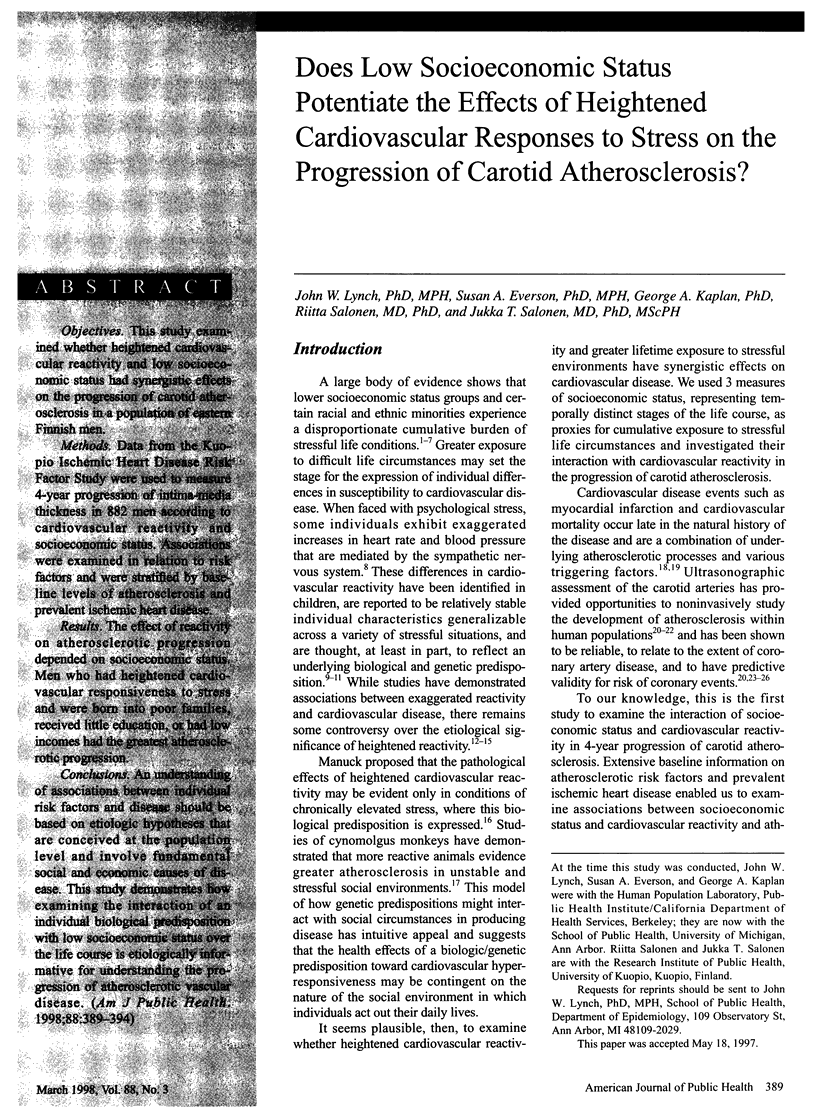
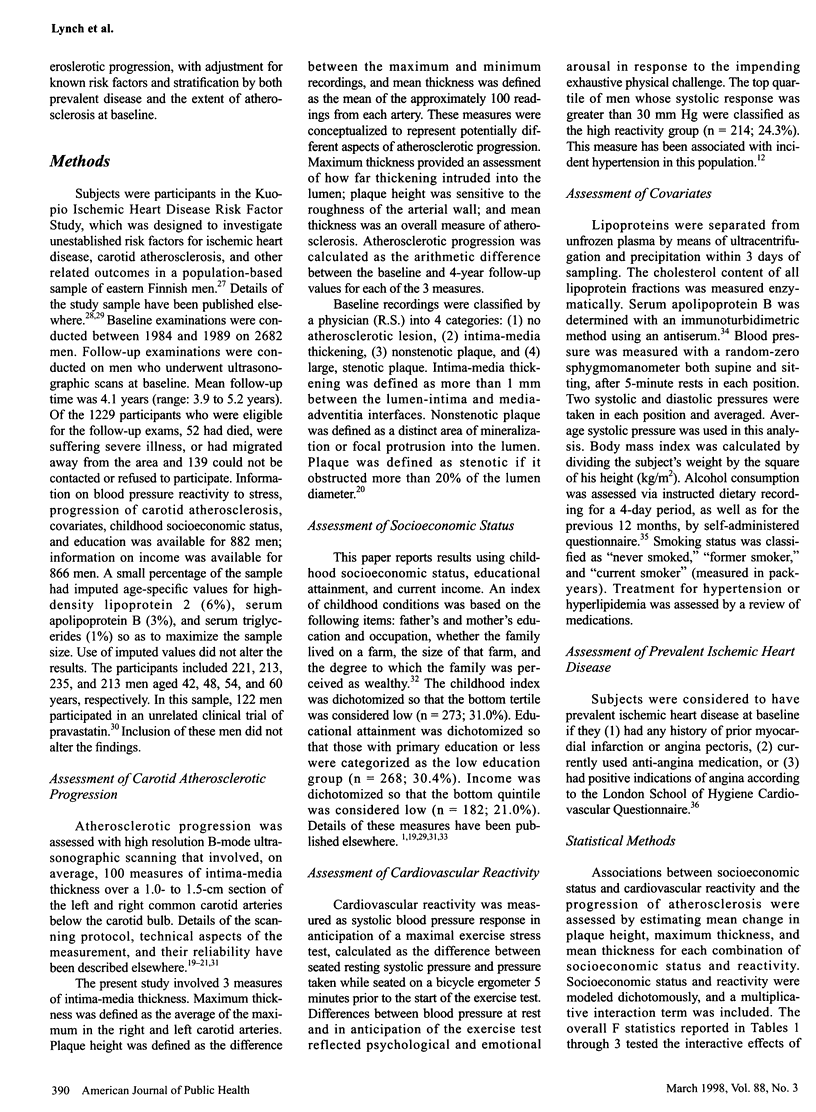
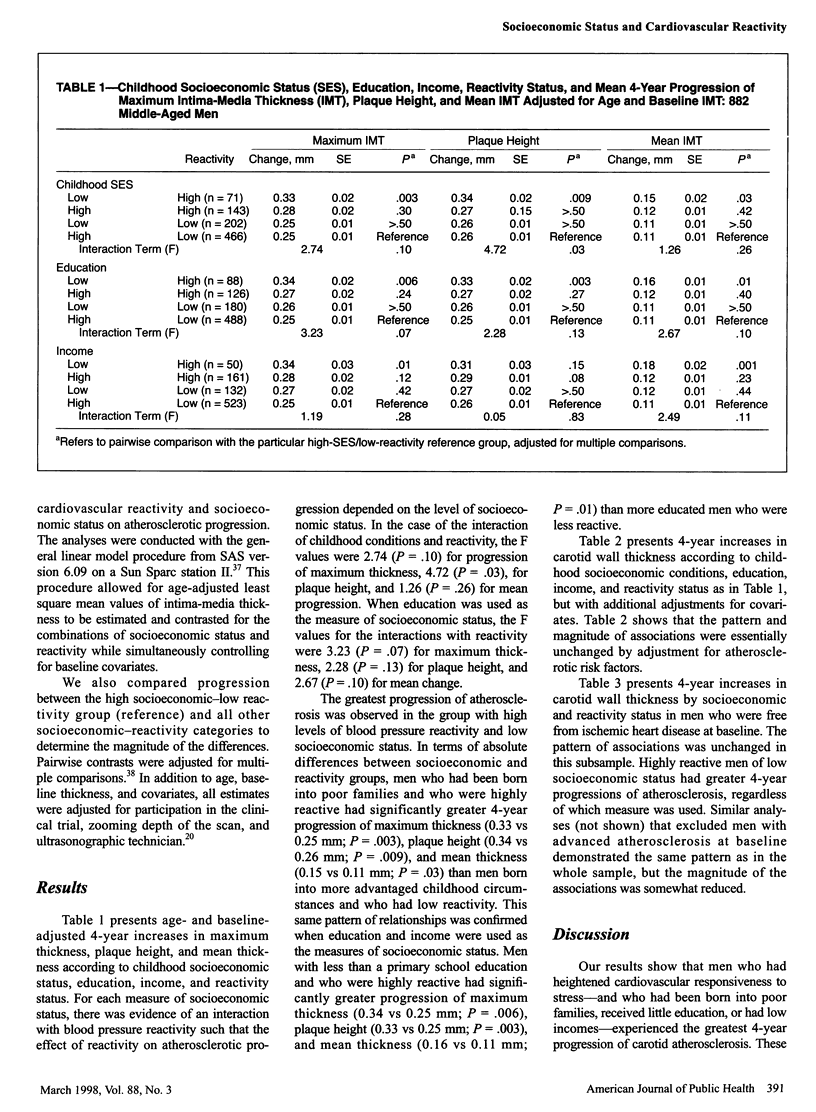
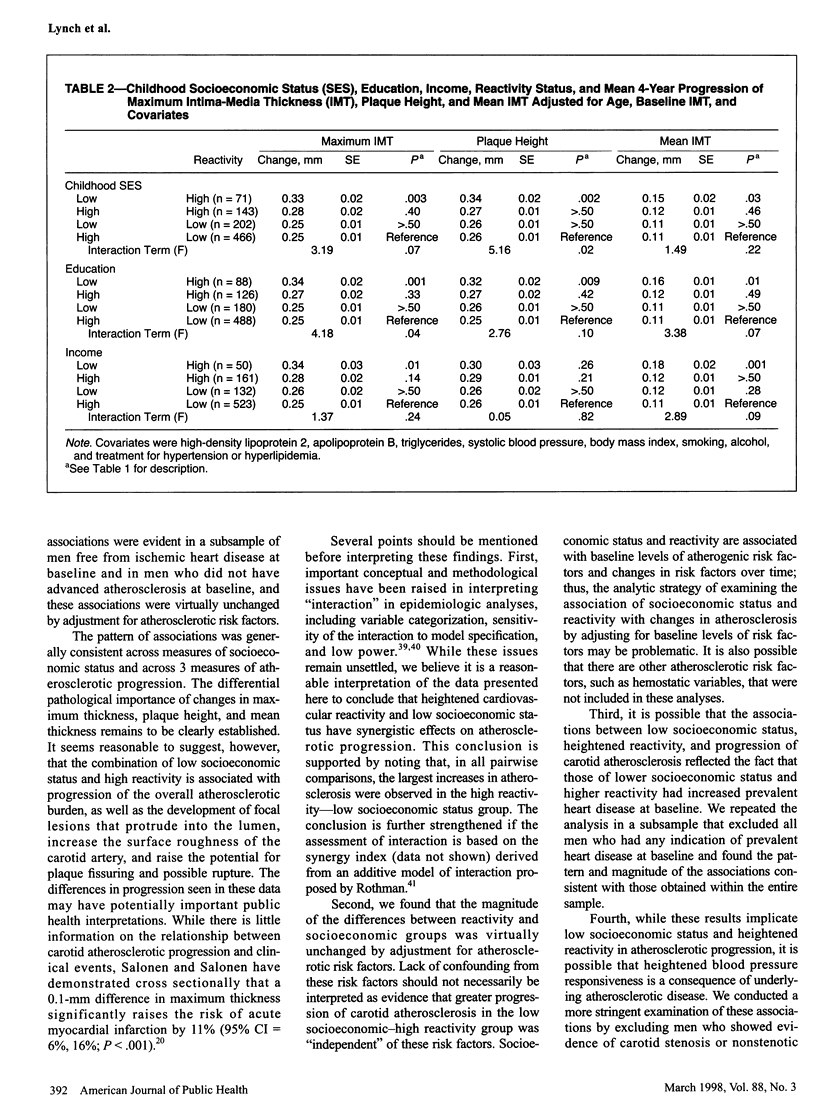
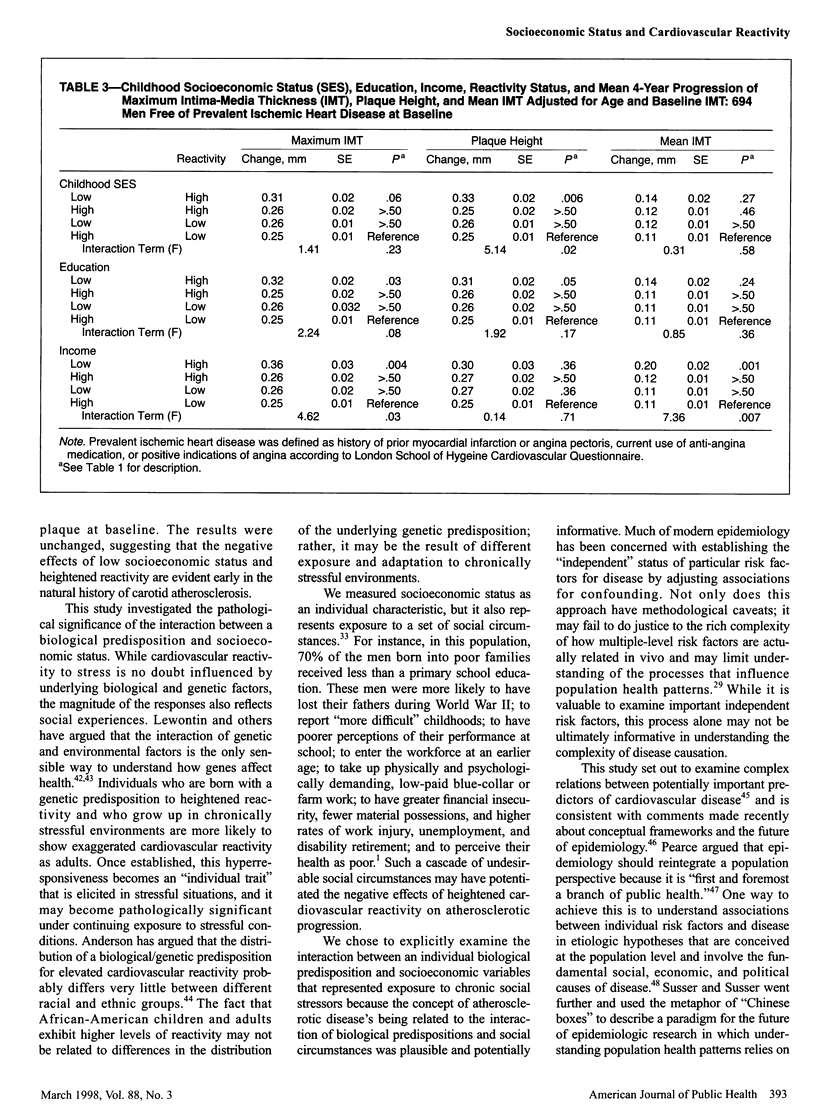
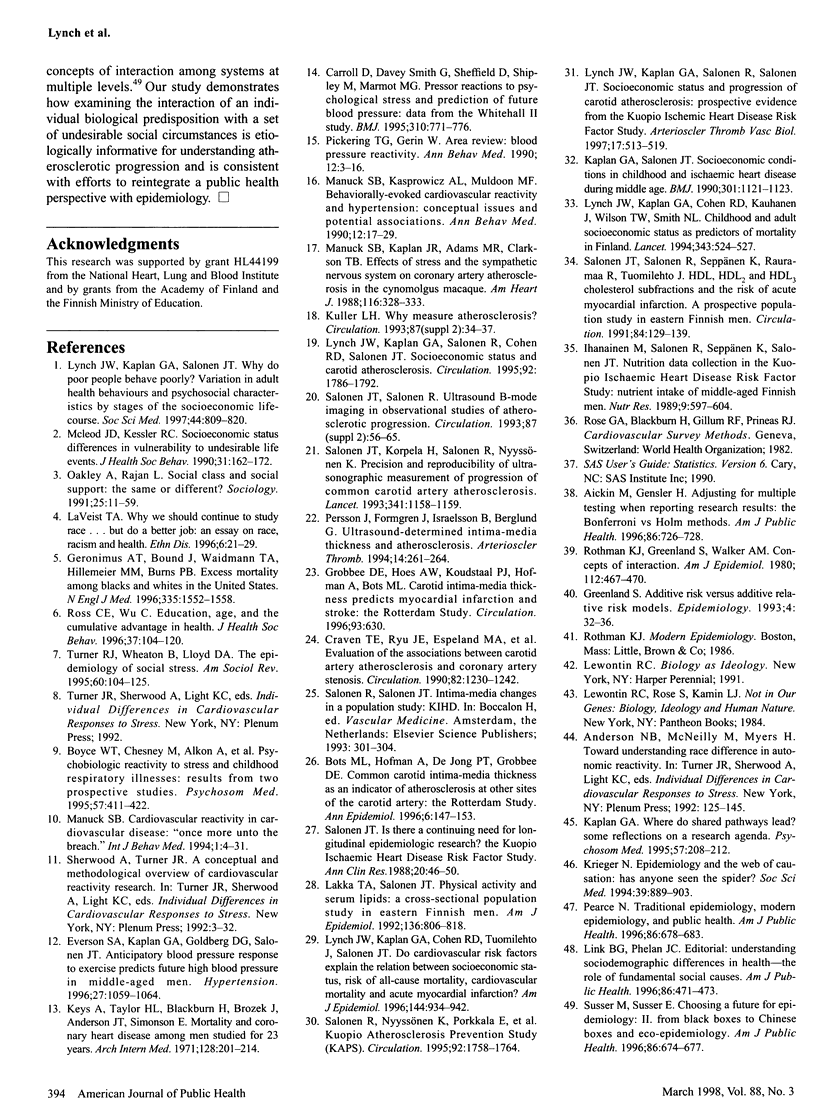
Selected References
These references are in PubMed. This may not be the complete list of references from this article.
- Aickin M., Gensler H. Adjusting for multiple testing when reporting research results: the Bonferroni vs Holm methods. Am J Public Health. 1996 May;86(5):726–728. doi: 10.2105/ajph.86.5.726. [DOI] [PMC free article] [PubMed] [Google Scholar]
- Bots M. L., Hofman A., De Jong P. T., Grobbee D. E. Common carotid intima-media thickness as an indicator of atherosclerosis at other sites of the carotid artery. The Rotterdam Study. Ann Epidemiol. 1996 Mar;6(2):147–153. doi: 10.1016/1047-2797(96)00001-4. [DOI] [PubMed] [Google Scholar]
- Boyce W. T., Chesney M., Alkon A., Tschann J. M., Adams S., Chesterman B., Cohen F., Kaiser P., Folkman S., Wara D. Psychobiologic reactivity to stress and childhood respiratory illnesses: results of two prospective studies. Psychosom Med. 1995 Sep-Oct;57(5):411–422. doi: 10.1097/00006842-199509000-00001. [DOI] [PubMed] [Google Scholar]
- Carroll D., Smith G. D., Sheffield D., Shipley M. J., Marmot M. G. Pressor reactions to psychological stress and prediction of future blood pressure: data from the Whitehall II Study. BMJ. 1995 Mar 25;310(6982):771–776. doi: 10.1136/bmj.310.6982.771. [DOI] [PMC free article] [PubMed] [Google Scholar]
- Craven T. E., Ryu J. E., Espeland M. A., Kahl F. R., McKinney W. M., Toole J. F., McMahan M. R., Thompson C. J., Heiss G., Crouse J. R., 3rd Evaluation of the associations between carotid artery atherosclerosis and coronary artery stenosis. A case-control study. Circulation. 1990 Oct;82(4):1230–1242. doi: 10.1161/01.cir.82.4.1230. [DOI] [PubMed] [Google Scholar]
- Everson S. A., Kaplan G. A., Goldberg D. E., Salonen J. T. Anticipatory blood pressure response to exercise predicts future high blood pressure in middle-aged men. Hypertension. 1996 May;27(5):1059–1064. doi: 10.1161/01.hyp.27.5.1059. [DOI] [PubMed] [Google Scholar]
- Geronimus A. T., Bound J., Waidmann T. A., Hillemeier M. M., Burns P. B. Excess mortality among blacks and whites in the United States. N Engl J Med. 1996 Nov 21;335(21):1552–1558. doi: 10.1056/NEJM199611213352102. [DOI] [PubMed] [Google Scholar]
- Greenland S. Additive risk versus additive relative risk models. Epidemiology. 1993 Jan;4(1):32–36. doi: 10.1097/00001648-199301000-00007. [DOI] [PubMed] [Google Scholar]
- Kaplan G. A., Salonen J. T. Socioeconomic conditions in childhood and ischaemic heart disease during middle age. BMJ. 1990 Nov 17;301(6761):1121–1123. doi: 10.1136/bmj.301.6761.1121. [DOI] [PMC free article] [PubMed] [Google Scholar]
- Kaplan G. A. Where do shared pathways lead? Some reflections on a research agenda. Psychosom Med. 1995 May-Jun;57(3):208–212. doi: 10.1097/00006842-199505000-00002. [DOI] [PubMed] [Google Scholar]
- Keys A., Taylor H. L., Blackburn H., Brozek J., Anderson J. T., Simonson E. Mortality and coronary heart disease among men studied for 23 years. Arch Intern Med. 1971 Aug;128(2):201–214. doi: 10.1001/archinte.1971.00310200037002. [DOI] [PubMed] [Google Scholar]
- Krieger N. Epidemiology and the web of causation: has anyone seen the spider? Soc Sci Med. 1994 Oct;39(7):887–903. doi: 10.1016/0277-9536(94)90202-x. [DOI] [PubMed] [Google Scholar]
- La Veist T. A. Why we should continue to study race...but do a better job: an essay on race, racism and health. Ethn Dis. 1996 Winter-Spring;6(1-2):21–29. [PubMed] [Google Scholar]
- Lakka T. A., Salonen J. T. Physical activity and serum lipids: a cross-sectional population study in eastern Finnish men. Am J Epidemiol. 1992 Oct 1;136(7):806–818. doi: 10.1093/aje/136.7.806. [DOI] [PubMed] [Google Scholar]
- Link B. G., Phelan J. C. Understanding sociodemographic differences in health--the role of fundamental social causes. Am J Public Health. 1996 Apr;86(4):471–473. doi: 10.2105/ajph.86.4.471. [DOI] [PMC free article] [PubMed] [Google Scholar]
- Lynch J. W., Kaplan G. A., Cohen R. D., Kauhanen J., Wilson T. W., Smith N. L., Salonen J. T. Childhood and adult socioeconomic status as predictors of mortality in Finland. Lancet. 1994 Feb 26;343(8896):524–527. doi: 10.1016/s0140-6736(94)91468-0. [DOI] [PubMed] [Google Scholar]
- Lynch J. W., Kaplan G. A., Cohen R. D., Tuomilehto J., Salonen J. T. Do cardiovascular risk factors explain the relation between socioeconomic status, risk of all-cause mortality, cardiovascular mortality, and acute myocardial infarction? Am J Epidemiol. 1996 Nov 15;144(10):934–942. doi: 10.1093/oxfordjournals.aje.a008863. [DOI] [PubMed] [Google Scholar]
- Lynch J. W., Kaplan G. A., Salonen J. T. Why do poor people behave poorly? Variation in adult health behaviours and psychosocial characteristics by stages of the socioeconomic lifecourse. Soc Sci Med. 1997 Mar;44(6):809–819. doi: 10.1016/s0277-9536(96)00191-8. [DOI] [PubMed] [Google Scholar]
- Lynch J., Kaplan G. A., Salonen R., Cohen R. D., Salonen J. T. Socioeconomic status and carotid atherosclerosis. Circulation. 1995 Oct 1;92(7):1786–1792. doi: 10.1161/01.cir.92.7.1786. [DOI] [PubMed] [Google Scholar]
- Lynch J., Kaplan G. A., Salonen R., Salonen J. T. Socioeconomic status and progression of carotid atherosclerosis. Prospective evidence from the Kuopio Ischemic Heart Disease Risk Factor Study. Arterioscler Thromb Vasc Biol. 1997 Mar;17(3):513–519. doi: 10.1161/01.atv.17.3.513. [DOI] [PubMed] [Google Scholar]
- Manuck S. B. Cardiovascular reactivity in cardiovascular disease: "once more unto the breach". Int J Behav Med. 1994;1(1):4–31. doi: 10.1207/s15327558ijbm0101_2. [DOI] [PubMed] [Google Scholar]
- Manuck S. B., Kaplan J. R., Adams M. R., Clarkson T. B. Effects of stress and the sympathetic nervous system on coronary artery atherosclerosis in the cynomolgus macaque. Am Heart J. 1988 Jul;116(1 Pt 2):328–333. doi: 10.1016/0002-8703(88)90110-x. [DOI] [PubMed] [Google Scholar]
- McLeod J. D., Kessler R. C. Socioeconomic status differences in vulnerability to undesirable life events. J Health Soc Behav. 1990 Jun;31(2):162–172. [PubMed] [Google Scholar]
- Pearce N. Traditional epidemiology, modern epidemiology, and public health. Am J Public Health. 1996 May;86(5):678–683. doi: 10.2105/ajph.86.5.678. [DOI] [PMC free article] [PubMed] [Google Scholar]
- Persson J., Formgren J., Israelsson B., Berglund G. Ultrasound-determined intima-media thickness and atherosclerosis. Direct and indirect validation. Arterioscler Thromb. 1994 Feb;14(2):261–264. doi: 10.1161/01.atv.14.2.261. [DOI] [PubMed] [Google Scholar]
- Ross C. E., Wu C. L. Education, age, and the cumulative advantage in health. J Health Soc Behav. 1996 Mar;37(1):104–120. [PubMed] [Google Scholar]
- Rothman K. J., Greenland S., Walker A. M. Concepts of interaction. Am J Epidemiol. 1980 Oct;112(4):467–470. doi: 10.1093/oxfordjournals.aje.a113015. [DOI] [PubMed] [Google Scholar]
- Salonen J. T. Is there a continuing need for longitudinal epidemiologic research? The Kuopio Ischaemic Heart Disease Risk Factor Study. Ann Clin Res. 1988;20(1-2):46–50. [PubMed] [Google Scholar]
- Salonen J. T., Korpela H., Salonen R., Nyyssönen K. Precision and reproducibility of ultrasonographic measurement of progression of common carotid artery atherosclerosis. Lancet. 1993 May 1;341(8853):1158–1159. doi: 10.1016/0140-6736(93)93184-3. [DOI] [PubMed] [Google Scholar]
- Salonen J. T., Salonen R., Seppänen K., Rauramaa R., Tuomilehto J. HDL, HDL2, and HDL3 subfractions, and the risk of acute myocardial infarction. A prospective population study in eastern Finnish men. Circulation. 1991 Jul;84(1):129–139. doi: 10.1161/01.cir.84.1.129. [DOI] [PubMed] [Google Scholar]
- Salonen R., Nyyssönen K., Porkkala E., Rummukainen J., Belder R., Park J. S., Salonen J. T. Kuopio Atherosclerosis Prevention Study (KAPS). A population-based primary preventive trial of the effect of LDL lowering on atherosclerotic progression in carotid and femoral arteries. Circulation. 1995 Oct 1;92(7):1758–1764. doi: 10.1161/01.cir.92.7.1758. [DOI] [PubMed] [Google Scholar]
- Susser M., Susser E. Choosing a future for epidemiology: II. From black box to Chinese boxes and eco-epidemiology. Am J Public Health. 1996 May;86(5):674–677. doi: 10.2105/ajph.86.5.674. [DOI] [PMC free article] [PubMed] [Google Scholar]


